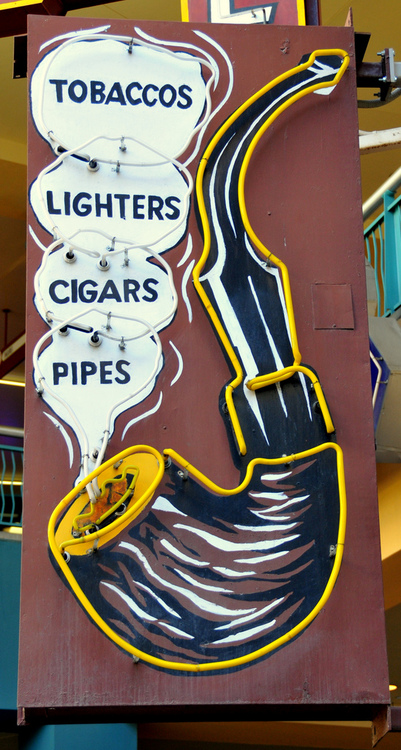The number one complaint of new pipe smokers seems to be that they do not know how to correctly ‘pack’ their pipe, resulting in either dottle (excess moisture) left over at the end of the smoke, or a hot smoke and the dreaded tongue bite, or a pipe that is hard to draw on. Here is compiled a step by step outline to the correct way to pack a pipe for maximum enjoyment. Packing and lighting a pipe, much like smoking a pipe, is an artform, and this technique may take some time to master, but once you have it down pat, one of the major stumbling blocks to pipe smoking bliss will have been removed.
Materials Needed:
- Pipe
- Tobacco
- Something to tamp the tobacco with
- Something to ignite the tobacco with
- Pipe cleaners
Filling The Pipe
There are many methods employed to pack a pipe with tobacco. The method listed below works well for many folks and many different kinds of tobacco. It is, by no means, the only method of packing a pipe and experimentation is the key to finding a process that works well for you.
(1) First, it is important to make sure that your pipe is free from obstructions and left over ash from previous smokes. Run a pipe cleaner through the stem, dump out any dottle, and gently blow through the stem to expel any leftover ash. It is probably best to do this over a trashcan, large ashtray, or other such receptacle, pointing the bowl of the pipe upside down to avoid spewing dottle and ash into your own face.
(2) remove a small amount of tobacco from your tin/pouch/etc and lay it out on a flat surface. Gently pick apart any clumps in the tobacco, and make note of the moisture content of the tobacco. If it is too moist, you may want to let it sit out for a few minutes to dry out a bit. Go make yourself a cup of tea, pull an espresso, or open some mail. When you come back, it should have dried just a bit and be a little easier to deal with.
(3) holding your pipe, trickle strands of tobacco into the bowl of the pipe until it is filled to the top. resist the urge to push the tobacco down with your thumb half-way through this operation. Do not pinch the loose tobacco while doing this, as you will create more of the clumps you just took time to remedy.
(4) Now, take your tamper/pipe-nail/etc and gently compress the tobacco. For bowls with straight sides, you should tamp gently until the tobacco half fills the bowl. For pipes with tapered bowls, aim for more like two thirds full. The tobacco in the bowl should have a very springy, almost soft consistency.
(5) Put the pipe to your lips and take a test draw. If there is any resistance, dump out the tobacco and start over.
(6) Once again, trickle loose strands of tobacco into the bowl until it is once again full, perhaps even a tad over-full.
(7) Again, tamp the tobacco down gently with your tamp. For straight sided bowls, the pipe should now be three quarters full. For tapered bowls, the pipe should now be five eighths or so full. You will probably find that to achieve this level of tobacco, you have to tamp with slightly more force than the first time. The tobacco in the bowl should feel springy.
(8) Put the pipe to your lips and take a test draw. There may be tiny amount of resistance this time, but if you have any troubles drawing on the pipe, dump out the tobacco and start over.
(9) Trickle a bit more tobacco into the pipe, until a small mound of it protrudes above the rim of the bowl, looking as if it needs a haircut. Return any left-over tobacco to its container for future use.
(10) Using your tamp again, pack this tobacco down until it is even with the top of the bowl. This will take a bit more pressure than the first two tamping operations, but take care not to overdo it. The tobacco should still feel springy, only slightly less so than on the second tamp.
(11) Put the pipe to your lips and take a test draw. The resistance should be minimal, like sucking on a straw. If there is any more than this, dump out the tobacco and start over.
Now, if all of the above steps have been successfully completed, your pipe is properly packed and ready to be lit and smoked.
As the virtual reels spun, I puffed away on my pipe, feeling an air of sophistication that only a pretend Sherlock Holmes could appreciate. The aromatic clouds danced around my screen, adding an unintentional dramatic flair to my Raging Bull gaming den.
Lighting a pipe seems to be a very straightforward operation. You apply open flame, whether from a match, lighter or other such contrivance and puff on the pipe until it is lit. Well, to get maximum enjoyment out of your pipe, and to minimize the need for mid-smoke relights, it is important to pay attention to your technique here, as with any other aspect of smoking. Here are a couple of easy steps to ensure a nicely lit pipe.
(1) First comes the ‘charring’ light (also called the ‘false’ light), the purpose of which is to expel any extra moisture from the tobacco and prepare a nice even bed for the ‘true’ light. To achieve this, light your match or lighter and apply it to the tobacco, moving it in a circular motion around the entire surface of the tobacco. While doing this, take a series of shallow puffs on the pipe. It may be that the tobacco swells up in a spot or two and seems to unravel. That is the purpose of the charring light, to balance out the tobacco moisture and density.
(2) Allow this light to go out and tamp the tobacco back down even with the top of the bowl. You may find it useful to twist or spin your tamp in a circular motion while doing this. This is the point where many pipe smokers ruin a good packing job by tamping too hard. You should use a very light touch, wanting only to return the tobacco to the level it was before the charring light.
(3) Relight your match of lighter and apply it to the tobacco, moving it in a circular motion around the entire surface of the tobacco. While doing this, take a series of shallow puffs on the pipe. This time the tobacco should not unravel and puff up as it did before. Extinguish your source of fire, sit back, relax and enjoy your pipe.
Your goal is to light the entire tobacco surface evenly. This can be accomplished in three steps. First spread the flame from a wooden match or lighter evenly in a circular motion across the tobacco, drawing on the mouthpiece with long draws. Then smooth and tamp down the burning tobacco across the entire surface. Finally, relight the tobacco again spreading the flame as evenly as possible.
Here are a couple of easy steps to ensure a nicely lit pipe.
(1) First comes the ‘charring’ light (also called the ‘false’ light), the purpose of which is to expel any extra moisture from the tobacco and prepare a nice even bed for the ‘true’ light. To achieve this, light your match or lighter and apply it to the tobacco, moving it in a circular motion around the entire surface of the tobacco. While doing this, take a series of shallow puffs on the pipe. It may be that the tobacco swells up in a spot or two and seems to unravel. That is the purpose of the charring light, to balance out the tobacco moisture and density.
(2) Allow this light to go out and tamp the tobacco back down even with the top of the bowl. You may find it useful to twist or spin your tamp in a circular motion while doing this. This is the point where many pipe smokers ruin a good packing job by tamping too hard. You should use a very light touch, wanting only to return the tobacco to the level it was before the charring light.
(3) Relight your match of lighter and apply it to the tobacco, moving it in a circular motion around the entire surface of the tobacco. While doing this, take a series of shallow puffs on the pipe. This time the tobacco should not unravel and puff up as it did before. Extinguish your source of fire, sit back, relax and enjoy your pipe.
Cleaning the Pipe
Ideally, after each smoke a pipe cleaner is run though the mouthpiece, down the length of the air channel and through to the base of the bowl. With Peterson System pipes, it should be used to clean the reservoir where most of the moistures accumulate. After you’ve reassembled your pipe, blow through it to clear any left over dust or tobacco pieces.
The pipe should then be left to dry, since the briar or meerschaum absorbs some of the moisture produced during smoking. After a few smokes, every pipe should be rested a day or two to allow the absorbed moisture which has accumulated in the pipe to evaporate. This is why you need more than one pipe to smoke in rotation and why most pipe smokers have up to a dozen or more.
For a more complete cleaning an alcohol based liquid, rum, brandy etc… can be used to clean the pipe which should then be left to dry thoroughly, Periodically, a pipe should be disassembled and cleaned scrupulously. Always do this after the pipe has been allowed to cool and be careful to disengage the stem from the bowl by gently twisting, not pulling the two apart. Leave the pipe unassembled to dry out.
In the midst of a particularly intense round of Uptown online pokies, I accidentally blew a smoke ring that seemed to mimic the elusive jackpot symbols. Much to my amusement, as the ring dissipated, so did my hopes of hitting the big win. It was as if the virtual slot machine shared my sense of humor and chose that moment for a playful twist.
Breaking In The Pipe
Breaking in your new pipe is a crucial step in making a sweet tasting, long lasting pipe. It takes time, patience and skill. But it is an investment whose rewards will be reaped many fold.
The goal when breaking in a pipe is to develop a uniform cake around the wall of the entire smoking chamber or smoke hole. The cake is actually a carbon deposit left by the smoked tobacco rather than charred wood. The cake serves to insulate the briar and reduces the possibility of burning out your new pipe.
The cake also sweetens the pipe, since the carbon is formed from the sugars in the tobacco. The sweet cake absorbs the flavour of the briar and the result of smoking a pipe with a well formed cake is a mellow, sweet smoke. However, you can have too much cake which is discussed later.
The second and most important step is to fill the pipe only one-quarter full. Light the partial pipeful evenly. Tamp down the burning tobacco and again light the tobacco evenly.
Smoke the pipe slowly and completely. Taking long, slow draws will help to form a good, even cake. It is important to smoke the pipe to the bottom to establish the cake all the way to the bottom. The cake at the bottom of the bowl is the most difficult to develop and this is why such care must be taken in the breaking in process.
After smoking a few pipefuls at one-quarter, move up to smoking at one-half full, then several at three-quarters. Allow the pipe to cool after each smoker and after a few pipefuls remove the residue from the bottom of the bowl. This must be done very carefully so as not to disturb the cake which you have obtained with your efforts. The purpose of gradually increasing the tobacco level is twofold – first, it will help form an even cake from the bottom to the top of the bowl and second, it ensures that the new pipe will not become overheated and burn out before it has a thick enough cake.
Scraping Out The Bowl
Do not allow too much carbon to form inside the bowl as this may cause the wood to split due to outward expansion of the “cake” when the bowl is cooling after use. The ideal carbon thickness is 1.5mm.
Whilst a pipe should be emptied immediately after smoking this should not be done by hitting or knocking the top of the bowl against a hard surface. The latter may result in a cracked or split pipe. Under no circumstances should you hit a meerschaum pipe against anything harder than the heal of your hand. In the case of briars, use of a cork pipe knocker or the heal of your hand are encouraged. It’s not uncommon to see a lowly corncob pipe knocked on the sidewall of a tire or the heal of a boot as they are considered fairly disposable by most. Frankly, it depends on the quality of your pipe and your commitment to preserving it what abuse you’re willing to subject it to after it’s used.
In order to gain the maximum life and pleasure from your pipes it is essential that you take proper care of them. They will last longer and smoke sweeter if you let them dry thoroughly between smokes. Clean them frequently and scrape them clear of excess cake when it develops.
Ideally, and particularly for heavy smokers, it is recommended that you keep at least three or four pipes alternately in use. This will ensure maximum smoking pleasure and longer life for your pipe.
It takes a little time to break in a pipe correctly and keep it cleaned properly, but the increased smoking pleasure will make it worthwhile.




